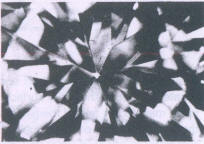The culet is a very small surface, cut parallel to the plane of the table, on the point of the stone, which it is intended to protect it from damage. As the light which falls perpendicularly on a stone emerges straight through the culet and thus causes a loss of light, the culet should be as small as possible, for a larger one looks, when seen through the table, like a black hole.
The size of the culet is visually examined through the table by 10 X magnification and described as:
very small, small, medium, large and very large.
If no culet is present, a "point" is referred.
Very small culets can be better seen if the stone is observed against the light or in transmitted light. The light then floods from below through the culet into the stone. Another aid in distinguishing between a too small and/or a point-like culet is to hold a finger under the stone. If a culet is present, the skin appears through it.
According to the degree of visibility the culet size can be classified as follows:
| pointed | no culet present; |
| very small culet | difficult to see under 10 x magnification; |
| small culet | perceptible under 10 x magnification; |
| medium culet | easily visible under 10 x magnification, but not visible with naked eye; |
| large culet | visible to the naked eye; |
| very large culet | easily visible to the naked eye. |
 The
culet is usually polished. A natural or rough culet is taken into account among
the features of polishing. Occasionally culets are damaged by fractures, they
then look white and prevent any transmission of light. They are considered under
external features (Fig29B).
The
culet is usually polished. A natural or rough culet is taken into account among
the features of polishing. Occasionally culets are damaged by fractures, they
then look white and prevent any transmission of light. They are considered under
external features (Fig29B).
| Edge displacement of crown and pavilion facets | Symmetry of the girdle |